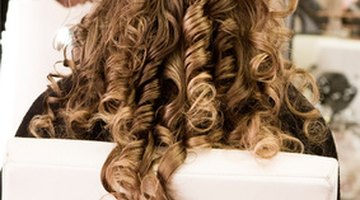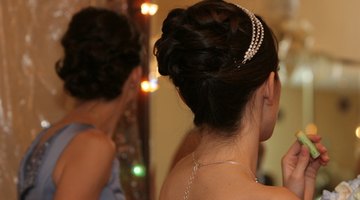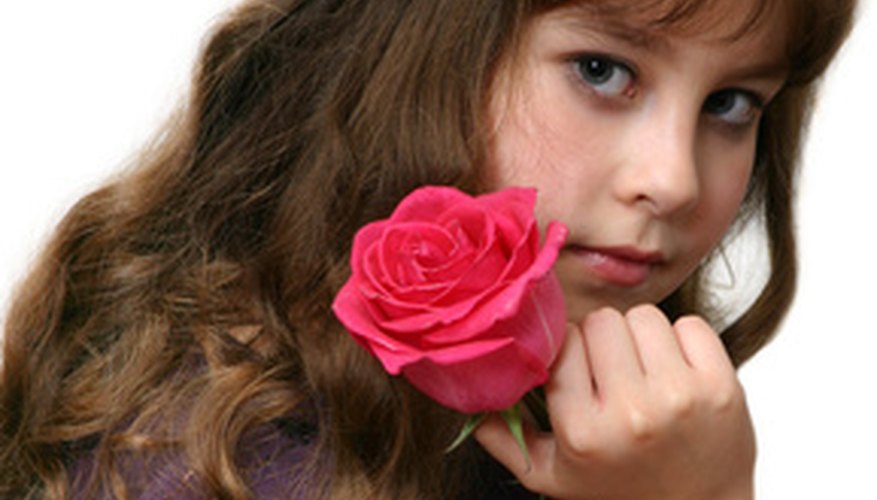Girls in the Victorian period (1837 to 1901) wore their hair long. Unless a girl was very ill, or a pauper in the workhouse, her hair would not be cut short. Short hair was reserved for men and school age boys. Below the age of 5, boys and girls looked much alike – both wore long hair and dresses. The Victorians idealised young children as the embodiment of innocence. Young children – especially well-to-do children – were to be curly-headed cherubs.
Everyday Style
Commonly girls' hair was worn loose, with a centre parting. Sometimes this style was cut with a fringe or drawn back under a hair band. Alternatively, sections of hair at each side of the head might be pulled back. These were twisted and secured with hairpins or tied back with a bow. On wealthier children, bows were often large. Outside, they wore hats – sun bonnets and straw hats for play; elaborate versions of ladies' hats for church. Poorer girls who worked as servants would have their hair braided or tied back and covered with a cap. If they were foundlings or orphans their hair might be cropped short on entry to the orphanage or workhouse.
- Commonly girls' hair was worn loose, with a centre parting.
- Poorer girls who worked as servants would have their hair braided or tied back and covered with a cap.
Ringlets

Curls were prized by Victorians. On losing his baby curls, a Victorian boy would have his hair cut short but artificial methods would be used to maintain a girl's curliness – especially for parties, church or in wealthy families. Commonly a girl's damp hair was coiled around rag strips, which were bound tightly around the twists of hair (see Resources). The child must sleep all night in these rags. On waking the rags would be removed and the hair would emerge in long curls known as “ringlets”. Ringlets too might be decorated with ribbon bows.
- Curls were prized by Victorians.
- Commonly a girl's damp hair was coiled around rag strips, which were bound tightly around the twists of hair (see Resources).
Putting the Hair Up

Putting the long hair up was symbolic of entering womanhood. While young girls wore their hair down, around aged 17, a girl would be permitted to put her hair up and her skirts would become full-length. Making her “debut” into society with the aim of finding a husband, she began dining with the adults and attending balls. For a girl of marriageable age to take her hair down or wear it loose was considered improper. In sexually mature girls, long, loose hair was associated with sensuality, vice and even madness. The sight of it loose hair would now be reserved for the husband and the bedroom.
- Putting the long hair up was symbolic of entering womanhood.
- The sight of it loose hair would now be reserved for the husband and the bedroom.
Sources of Inspiration
Good sources for images of Victorian girls' hairstyles are Victorian paintings, photographs, literature and advertising. Paintings like John Everett Millais' “My First Sermon” show the idealised curly-headed young girl. Millais' “A Child's World” was used in Pears Soap advertising and renamed, “Bubbles”. Pears Soap advertisements feature many images of curly-headed, centre-parted girls and boys.
Sophie Anderson's paintings show similarly sentimental images. Her “No Walk Today” shows a girl with curled hair and elaborate bows beneath her hat. Lewis Carroll's “Alice in Wonderland” demonstrates the typical loose hairstyle with hairband. Alice Liddel, the real life model for “Alice” was much photographed by Carroll and is shown with a simple centre parting and fringe.
- Good sources for images of Victorian girls' hairstyles are Victorian paintings, photographs, literature and advertising.
- Alice Liddel, the real life model for “Alice” was much photographed by Carroll and is shown with a simple centre parting and fringe.
